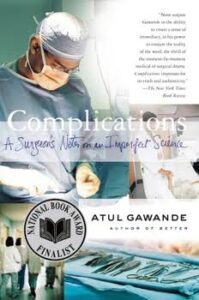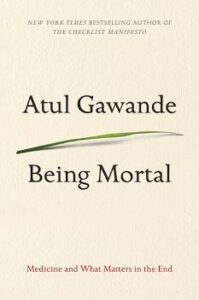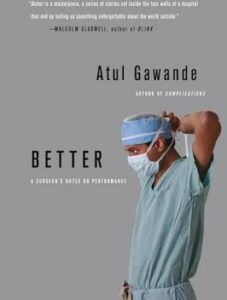


BEING MORTAL And that is what Gawande emphasizes in this book: choice. The cases he relates are all about allowing the patient to decide: should I have another surgery when death could be less than weeks away?
We are all mortal. We are all going to die. And yet each day when we rise with that virtual list pounding in our heads as to what we have to accomplish, death is never on the list. And it shouldn’t be. But one day it will be–though it may be totally unexpected. Because–yes, we are all mortal.
In his comprehensive and helpful book Being Mortal, Dr. Atul Gawande (Complications, Better, The Checklist Manifesto) once again forges new territory as he educates physicians, other medical personnel and us about the importance of choice when one is severely ill or close to death. Because though doctors are trained to heal and to save, more and more patients and their caregivers realize that how we will be living, the quality of life we will have, should be a major consideration when making difficult decisions about surgery, chemotherapy, clinical trials, etc.
Gawande recounts the story of a daughter whose father was hospitalized with cancer–a tumor growing and filling his spinal column. While driving across the Golden Gate Bridge to her home, she was thinking about her father’s surgery that was scheduled for the following morning and all that the doctor had said. It was almost midnight. But she suddenly realized that she didn’t really know what her father wanted. Yes, the doctor had talked about possible outcomes–but nothing had been settled. She turned around and drove back to the hospital, waking her father and asking him: If the surgery results in you gradually becoming a quadriplegic is that really acceptable? He thought for a while, and finally answered yes. As long as he could eat chocolate ice cream and read he would accept the gradual loss of movement that might occur. The doctor was removing some of the spinal tumor but had stressed that he couldn’t get it all, and the chances of it growing back were strong. So they talked! The daughter and her father had the conversation so that depending on the results of the surgery — if he woke up or if for some unknown reason he didn’t wake up — she knew — no intubation, no Intensive Care Unit for months and months…because that would mean no chocolate ice cream, no reading.
AN ADVERTISEMENT
Gawande writes about Keren Brown Wilson who is credited with creating the model and the term assisted living. She fought for funding and was finally able in 1981 to open Park Place in Oregon, utilizing the following definition of the type of care the facility was offering: Assisted living… is a program that promotes resident self-direction and participation in decisions that emphasize choice, dignity, privacy, individuality, independence and homelike surroundings.
One of the things Wilson assured her clients, something they had asked for: each home or unit would have a lock on its door. Because nursing homes were more like large wards where people had little that they could identify as theirs, and staff had access to their “space” whenever they considered it necessary. Wilson’s experiment was a huge success and assisted living facilities sprung up all over the United States. Some statistics: since 1981 there are 40,000 more assisted living facilities. http://www.assistedlivinghistory.com
The assisted living model includes 24 hour staffing so there is always someone “in house” to provide needed care. Residents have their own home or apartment and they can prepare meals if they choose to, but there is often a community area for eating meals and participating in activities. Today, many senior living residences have a variety of living options: independent and assisted living areas; special care units, so as a client ages or health deteriorates, there is 24 hour nursing care; and also a locked unit for Alzheimer’s and dementia.
The most affecting portion of the book is Gawande’s open discussion of helping his father who also developed a tumor in his spine and slowly found his independent life as a doctor, husband and father slipping away. The irony of researching and writing this book and then being faced with the very same difficult and personal issues of those he had interviewed underlines the strength of this physician-writer.
Certainly, suffering at the end of life is sometimes unavoidable and unbearable, and helping people end their misery may be necessary. Given the opportunity, I would support laws to provide these kinds of prescriptions to people. About half don’t even use their prescription. They are reassured just to know they have this control if they need it. But we damage entire societies if we let providing this capability divert us from improving the lives of the ill. Assisted living is far harder than assisted death, but its possibilities are far greater, as well.
The last sentence rang true for me as I watched my mother experience living alone in her condo, then losing her ability to drive, then finally agreeing to move to a senior center. She did so with the hope that she could reside in independent living. But the beginning of her dementia signaled that assisted living would be her destination. As the months piled on, I often had to remind her to go to dinner or to take her medication. Soon the nurse was in control of that, and as the disease progressed Mom finally lived in the memory unit, something that was very hard for me and my family. There was no other solution. Her dementia prevented her from living with us as she could never be left alone near a stove or other appliance that might do her harm or worse. Reading Gawande’s BEING MORTAL underlined for me that my brothers and I made the right choices.
And that is what Gawande emphasizes in this book: choice. The cases he relates are all about allowing the patient to decide: should I have another surgery when death could be less than weeks away? Decision: no. Hospice: yes. Gawande takes us on his own personal journey of watching Hospice nurses do their work. He is amazed at how they approach a dying client and how they are able to help this person choose what they need as the last journey begins.
Gawande writes: When it is hard to know what will happen, it is hard to know what to do. But the challenge, I’ve come to see, is more fundamental than that. One has to decide whether one’s fears or one’s hopes are what should matter most.

One Response
Such an important subject. My mother, who is 90, always says she doesn’t want any life-prolonging procedures. “There are worse things than death,” she has said, and she means suffering. I agree with that and hope when her time comes, she goes fast and peacefully.